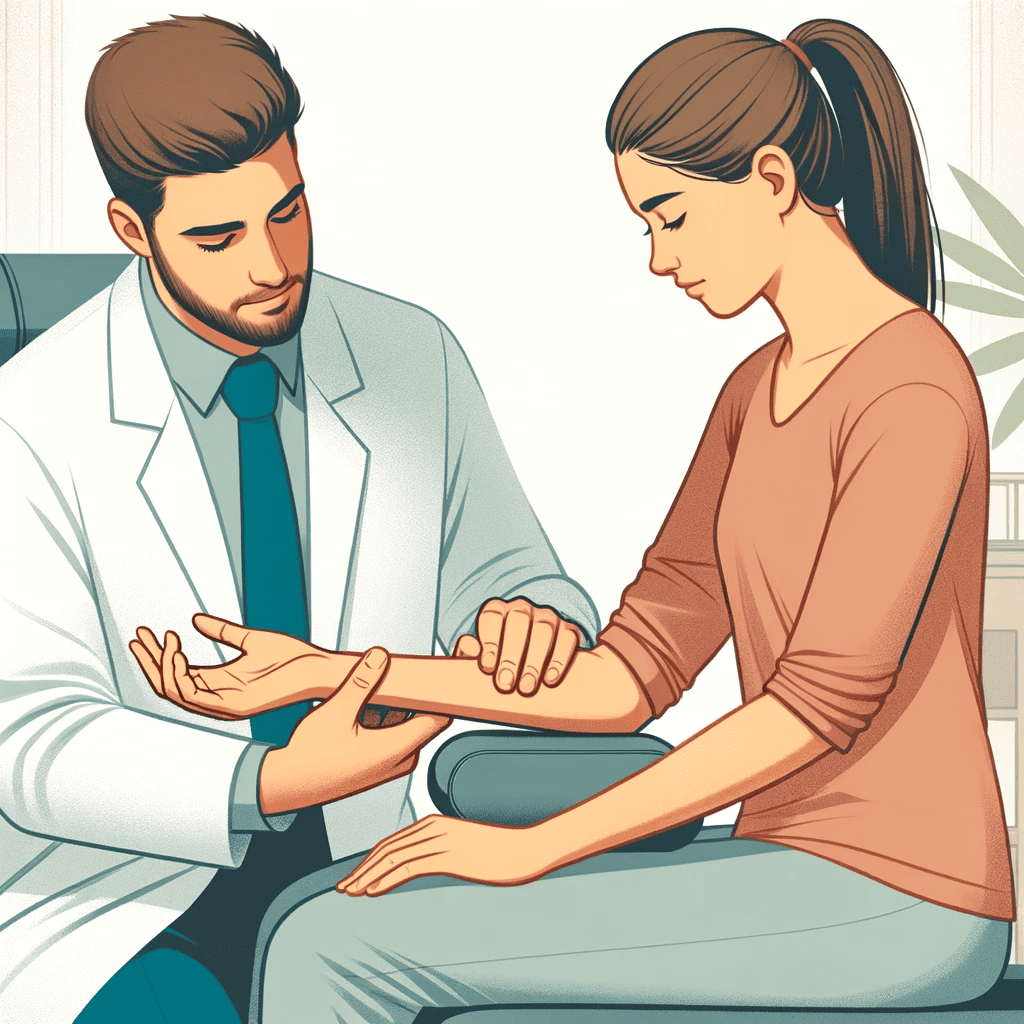As our daily tasks increasingly revolve around digital devices, the silent rise of Carpal Tunnel Syndrome (CTS) becomes a pressing concern for many. Amidst various treatment options, the role of a carpal tunnel chiropractor emerges as a beacon of hope. Positioned at the intersection of traditional and innovative care, these specialists provide a hands-on approach not just to manage but also to alleviate the root causes of wrist pain. Continue on this journey as we unfold the benefits and intricacies of chiropractic interventions for CTS.
Understanding CTS
Carpal tunnel syndrome is more than just occasional wrist pain. It’s a progressive condition that can severely impact daily activities if left untreated.
Causes of Carpal Tunnel
The carpal tunnel is a narrow passageway located on the palm side of your wrist [1]. It houses the median nerve and several tendons. When the tunnel becomes compressed or the tendons inflamed, it can put pressure on the median nerve, leading to CTS.
Common causes include:
- Repetitive wrist motions, such as typing or assembly line work.
- Pregnancy, due to fluid retention.
- Conditions like diabetes, rheumatoid arthritis, or thyroid gland imbalance.
Symptoms and Diagnosis
Symptoms of CTS can vary but typically include:
- Numbness, tingling, or pain in the hand and fingers, especially the thumb, index, and middle fingers.
- Weakness in the hand, making it hard to grasp objects.
- Pain that travels up the arm.
To diagnose CTS, a healthcare professional may conduct physical examinations, nerve tests, or imaging like X-rays.

Risk Factors and Prevention
Some individuals are more predisposed to CTS due to:
- Genetics, as smaller carpal tunnels can be inherited.
- Lifestyle or job factors, especially those involving repetitive wrist work [2].
- Previous wrist injuries.
Prevention strategies include:
- Taking regular breaks from repetitive tasks.
- Wrist exercises to strengthen and improve flexibility.
- Ergonomic improvements in workspace setups.
Chiropractic Adjustments: A Carpal Tunnel Chiropractor’s Approach
A carpal tunnel chiropractor focuses on the alignment of the wrist bones, ensuring the carpal tunnel remains as open as possible. Through gentle adjustments, they can:
Wrist Alignment Techniques
The alignment of the wrist bones can play a crucial role in the onset and progression of CTS. A chiropractor can:
- Assess the alignment of the carpal bones.
- Make gentle adjustments to correct misalignments, ensuring the carpal tunnel is as open as possible.
Benefits of Manual Adjustments
Manual adjustments by chiropractors can:
- Reduce inflammation in the wrist area.
- Improve nerve function and blood flow.
- Offer immediate relief from pain and numbness.
Frequency of Chiropractic Sessions for Relief
The number of sessions required can vary based on the severity of the condition and individual response to treatment. Typically:
- Initial intensive phase: 2-3 sessions per week.
- As symptoms reduce: Weekly to bi-weekly visits.
- Maintenance phase: Monthly sessions to prevent recurrence.
Comparing Treatment Options
There are multiple approaches to treat CTS. Let’s dive into how chiropractic care stacks up against other methods.

Comparing Treatment Options: Carpal Tunnel Chiropractor vs. Surgery
While both methods have their advantages, here are some key points to consider:
- Carpal Tunnel Chiropractor:
- Non-invasive and drug-free.
- Focuses on addressing the root cause.
- May offer immediate relief.
- Surgery:
- Usually considered when other treatments fail.
- Involves cutting the ligament around the wrist to relieve pressure.
- Longer recovery time and potential complications.
Natural Remedies for Carpal Tunnel Pain
Apart from chiropractic care, some natural remedies include:
- Wrist splints to keep the wrist in a neutral position [3].
- Cold packs to reduce inflammation.
- Herbs like turmeric and arnica for their anti-inflammatory properties.
Pros and Cons of Different Treatments
Every treatment option has its benefits and drawbacks. For instance:
- Chiropractic care is non-invasive but may require multiple sessions.
- Medications offer temporary relief but can have side effects.
- Surgery may provide a permanent solution but comes with risks and recovery time.
Success Stories and Testimonials
There’s no better way to understand the efficacy of a treatment than hearing from those who’ve experienced it.
Patient Experiences with Carpal Tunnel Chiropractors
- Sarah, a graphic designer: “After just a few sessions, the numbness in my fingers reduced drastically.”
- Mike, an accountant: “I was skeptical at first, but now I can’t imagine life without my chiropractic sessions.”
Long-term Benefits and Outcomes
Many patients report:
- Improved sleep due to reduced pain.
- Better hand strength and flexibility.
- Reduction or complete elimination of medications.
Case Studies of Severe Carpal Tunnel Cases
Detailed examinations of cases where individuals with severe CTS found relief through chiropractic care can offer in-depth insights.
Post-Treatment Care and Rehabilitation
Receiving treatment is just half the battle. Proper post-treatment care is essential to ensure lasting relief and prevent recurrence.
Exercises for Strengthening the Wrist
Regular exercises can significantly improve wrist strength and flexibility:
- Wrist Flexor Stretch: Extend your arm forward, palm up. Use your opposite hand to bend your wrist, pulling the fingers back towards you [4].
- Wrist Extensor Stretch: Similar to the flexor stretch but with the palm facing down.
- Tendon Glide Exercise: Start with your fingers straight, then make a series of fists (starting with a straight fist and progressing to a tight fist) and finally straighten them out again.
Importance of Regular Check-ups
Routine check-ups can:
- Identify any potential relapses early.
- Adjust treatment plans based on progress.
- Modify exercise regimens for optimal results.

Maintaining Wrist Health after Treatment
To keep the wrist healthy post-treatment:
- Maintain proper wrist posture during daily activities.
- Use ergonomic keyboards and mouse pads.
- Wear wrist braces during activities that strain the wrist.
The Benefits of Early Intervention with a Carpal Tunnel Chiropractor
Seeking treatment from a chiropractor at the early stages of CTS can have several advantages:
Reducing the Chances of Surgery
Early chiropractic care can:
- Alleviate symptoms before they become severe.
- Decrease inflammation and prevent further nerve damage.
- Reduce or eliminate the need for surgical intervention.
Importance of Early Diagnosis
Detecting CTS in its early stages:
- Allows for more treatment options.
- Reduces the risk of permanent nerve damage.
- Can lead to faster and more effective recovery.
How Chiropractic Care Can Slow Down the Progression of Carpal Tunnel
Regular adjustments:
- Keep the wrist bones properly aligned [5].
- Reduce inflammation and strain on the median nerve.
- Improve overall wrist and hand function.
Choosing the Right Carpal Tunnel Chiropractor
When it comes to finding the best care for your CTS, selecting the right carpal tunnel chiropractor is essential. During your initial consultation, ask about their experience with treating CTS, their approach, and the techniques they employ.
Questions to Ask During Consultation
- What’s your experience with treating carpal tunnel syndrome?
- How many CTS patients do you see in a typical month?
- What techniques or approaches do you use specifically for CTS?
Certifications and Qualifications
Ensure your chiropractor:
- Is licensed in your state.
- Has relevant certifications in chiropractic care.
- Continues their education to stay updated with the latest techniques.
Tips for Finding a Reputable Chiropractor
- Ask for referrals from friends or family.
- Read online reviews and testimonials.
- Consult your primary care physician for recommendations.
Conclusion
Carpal Tunnel Syndrome, while challenging, doesn’t have to dictate the quality of your life. With the right chiropractic care, you can navigate the path to recovery and regain the freedom of pain-free movement. Whether you’re considering chiropractic adjustments or are just beginning your journey, this guide provides a comprehensive overview to help you make informed decisions about your health.
With Eastside Ideal Health’s expert chiropractors, overcome Carpal Tunnel Syndrome and regain pain-free movement, as detailed in our comprehensive guide.


Recent Comments